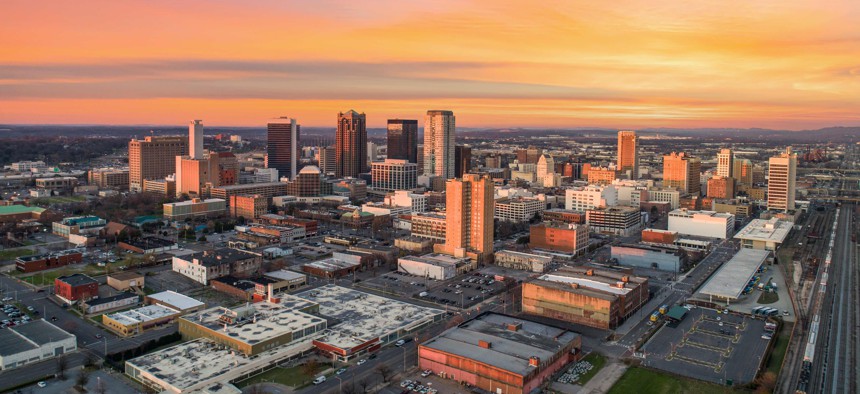This Week in Federal Funding

The skyline of Birmingham, Alabama. The city was an early mover with the Opportunity Zones program. It's possible cities could use similar strategies as they tap newly available federal aid. iStock.com/Kruck20
In the July 27 edition we talk with urbanist Bruce Katz about ways local governments can strategize to take full advantage of new federal dollars and why he made a comparison between pandemic aid and the Amazon HQ2 competition.
Route Fifty's This Week in Federal Funding newsletter provides weekly updates on what's happening with the pandemic-era aid dollars the federal government is sending to states and localities. The newsletter goes out on Tuesdays and Route Fifty Today subscribers receive it automatically. If you don't subscribe to Route Fifty Today and would like to receive This Week in Federal Funding, you can sign up for it here.
***
Welcome to Route Fifty's This Week in Federal Funding! I'm Senior Editor Bill Lucia.
From R50 this week: Columnists Katherine Barrett and Richard Greene take a look at tensions between governors and state legislators over who should control how American Rescue Plan Act dollars are spent. Liz Farmer covers how states and localities are handling ARPA's robust compliance and reporting requirements. And managing editor Jean Dimeo has an update on $3 billion in funding available from the U.S. Economic Development Administration.
What we're watching: Cross-sector collaboration. A couple weeks ago, urbanist Bruce Katz, director of the Nowak Metro Finance Lab at Drexel University, made an observation on Twitter about federal pandemic aid programs. He wrote: "Sitting on the Sidelines: local corporations, biz chambers, universities and philanthropies bet big on the Amazon HQ2 competition; with a few exceptions, they have been slower to help their cities organize for unprecedented federal investment — trying to sort out why." For those who don't remember, the Amazon HQ2 competition happened back around 2017-18, with cities vying to become the home of the tech giant's new second headquarters.
I talked to Katz this week about what he was getting at with his tweet. "Everyone went for Amazon HQ2 and they threw a lot of money at it. They hired consultants, they made their best shot," he said, adding that he hasn't seen—at least not yet—the same degree of organizing around the windfall of ARPA funding. "Amazon HQ2, in some respects, was an easy thing to prepare for because you knew what was at the end of the rainbow. A major global corporation is bringing 50,000 jobs," he said. "Here what's at the end of the rainbow are your own strategies."
Katz pointed out that while there's a lot of attention on the direct aid going to states and localities, that's just one segment of ARPA money. For example, there's the new EDA programs that governments can tap into. And Katz highlights the $10 billion State Small Business Credit Initiative as another pool of funding with great potential—"the sleeping giant of ARPA" as he puts it. (The Nowak folks have more on that program here.)
The gist of what Katz is saying is this: If a local government sets clear priorities for how it wants to capitalize on all the different pots of federal money available; if they work with the business, philanthropic and higher education communities to come up with a game plan for achieving those goals; and if they look for ways to add other nonfederal investments into the mix, then they are going to be in a stronger position to take advantage of the federal funding. Katz predicts that in the coming months some cities will move in this direction and begin to organize around the new aid in ways that are similar to how they approached the federal Opportunity Zones program.
"I think some places are prepared for this and they will reap the rewards of federal investment. We'll be looking back 20 years from now and saying those are the places that really hit it out of the park. They were able to put together strategies that implicated not one funding source, but 15 or 20," he said. "That's what it will take to do something of heft."
"If you can declare your local vision and cost out local uses, whether it's around small business, or whether it's around real estate, or whether it's around infrastructure, then you can match the federal sources and get the maximum bang for the buck," he added.
Katz said the Nowak Metro Finance Lab plans to put together a "playbook" to help communities make "place-based investments" using federal funding available under ARPA and other laws. "I think we're still [in the] early days of organizing for federal money," he said.
Elsewhere… Housing advocates in Milwaukee, Wisconsin are pushing for half of the roughly $394 million of ARPA money the city will receive to go to affordable housing programs, and say that a proposal Mayor Tom Barrett put forward for spending the money falls short on this front. The Milwaukee Journal Sentinel has more.
States are beginning the process of releasing the ARPA funds that they're responsible for passing to smaller-sized, "non-entitlement" units of local government. Illinois, New Mexico and Kentucky are among the places that have made announcements about this in recent days.
That's it for this week. In the meantime, if you have news tips or feedback on what we should be covering, if you want to share your community's story, or if you just want to say hello, please email us at: editor@routefifty.com. Thanks for reading!
This week's federal funds stories from Route Fifty:
- The Accounting Burden for Spending Federal Stimulus Funds
- Legislators and Governors Battle Over Who Spends the Rescue Act Money
- Feds Reveal Programs For $3B in Local Economic Development Funds
For last week's edition, which looks at the work of a federal watchdog agency overseeing pandemic aid programs, click here.






